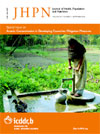
|
The Journal of Health, Population and Nutrition
icddr,b
ISSN: 1606-0997
EISSN: 1606-0997
Vol. 37, No. 1, 2018, pp. 1
|
 Bioline Code: hn18011
Bioline Code: hn18011
Full paper language: English
Document type: Research Article
Document available free of charge
|
|
|
The Journal of Health, Population and Nutrition, Vol. 37, No. 1, 2018, pp. 1
| en |
Health-related quality of life determinants among Rwandan women after delivery: does antenatal care utilization matter? A cross-sectional study
Hitimana, Regis; Lindholm, Lars; Krantz, Gunilla; Nzayirambaho, Manasse; Condo, Jeanine; Sengoma, Jean Paul Semasaka & Pulkki-Brännström, Anni-Maria
Abstract
Background: Despite the widespread use of antenatal care (ANC), its effectiveness in low-resource settings remains
unclear. In this study, self-reported health-related quality of life (HRQoL) was used as an alternative to other
maternal health measures previously used to measure the effectiveness of antenatal care.
The main objective of this study was to determine whether adequate antenatal care utilization is positively
associated with women’s HRQoL. Furthermore, the associations between the HRQoL during the first year (1–13 months) after delivery and socio-economic and demographic factors were explored in Rwanda.
Methods: In 2014, we performed a cross-sectional population-based survey involving 922 women who gave birth
1–13 months prior to the data collection. The study population was randomly selected from two provinces in
Rwanda, and a structured questionnaire was used.
HRQoL was measured using the EQ-5D-3L and a visual analogue scale (VAS). The average HRQoL scores were
computed by demographic and socio-economic characteristics. The effect of adequate antenatal care utilization on
HRQoL was tested by performing two multivariable linear regression models with the EQ-5D and EQ-VAS scores as
the outcomes and ANC utilization and socio-economic and demographic variables as the predictors.
Results: Adequate ANC utilization affected women’s HRQoL when the outcome was measured using the EQ-VAS.
Social support and living in a wealthy household were associated with a better HRQoL using both the EQ-VAS and
EQ-5D. Cohabitating, and single/unmarried women exhibited significantly lower HRQoL scores than did married
women in the EQ-VAS model, and women living in urban areas exhibited lower HRQoL scores than women living
in rural areas in the ED-5D model. The effect of education on HRQoL was statistically significant using the EQ-VAS
but was inconsistent across the educational categories. The women’s age and the age of their last child were not
associated with their HRQoL.
Conclusions: ANC attendance of at least four visits should be further promoted and used in low-income settings.
Strategies to improve families’ socio-economic conditions and promote social networks among women, particularly
women at the reproductive age, are needed.
Keywords
Antenatal care; Health-related quality of life; HRQoL; MaTHeR; Social support; Wealth; Postnatal women
|
| |
© Copyright 2018 - The Author(s)
Alternative site location: http://www.jhpn.net
|
|
